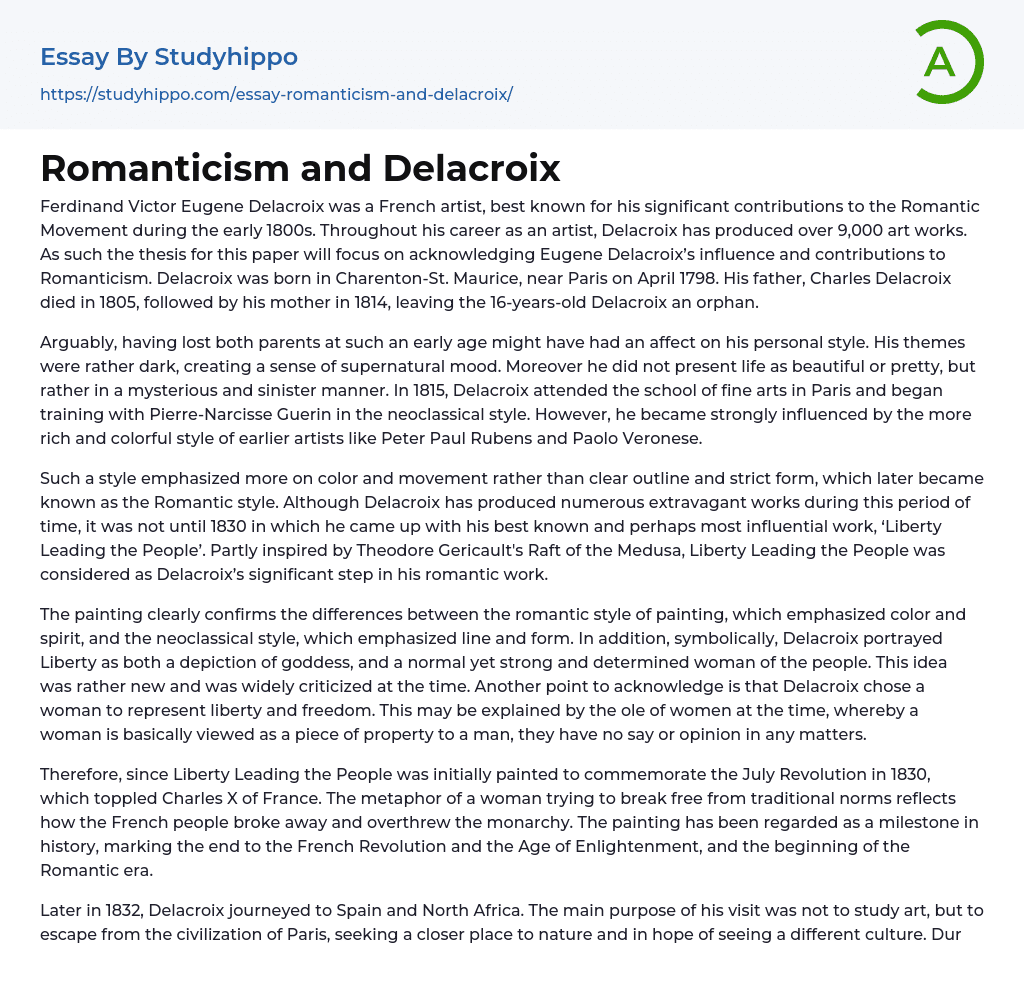Ferdinand Victor Eugene Delacroix was a French artist, best known for his significant contributions to the Romantic Movement during the early 1800s. Throughout his career as an artist, Delacroix has produced over 9,000 art works. As such the thesis for this paper will focus on acknowledging Eugene Delacroix’s influence and contributions to Romanticism. Delacroix was born in Charenton-St. Maurice, near Paris on April 1798. His father, Charles Delacroix died in 1805, followed by his mother in 1814, leaving the 16-years-old Delacroix an orphan.
Arguably, having lost both parents at such an early age might have had an affect on his personal style. His themes were rather dark, creating a sense of supernatural mood. Moreover he did not present life as beautiful or pretty, but rather in a mysterious and sinister manner. In 1815, Delacroix attended the sch
...ool of fine arts in Paris and began training with Pierre-Narcisse Guerin in the neoclassical style. However, he became strongly influenced by the more rich and colorful style of earlier artists like Peter Paul Rubens and Paolo Veronese.
Such a style emphasized more on color and movement rather than clear outline and strict form, which later became known as the Romantic style. Although Delacroix has produced numerous extravagant works during this period of time, it was not until 1830 in which he came up with his best known and perhaps most influential work, ‘Liberty Leading the People’. Partly inspired by Theodore Gericault's Raft of the Medusa, Liberty Leading the People was considered as Delacroix’s significant step in his romantic work.
The painting clearly confirms the differences between the romantic style of painting, which emphasized
color and spirit, and the neoclassical style, which emphasized line and form. In addition, symbolically, Delacroix portrayed Liberty as both a depiction of goddess, and a normal yet strong and determined woman of the people. This idea was rather new and was widely criticized at the time. Another point to acknowledge is that Delacroix chose a woman to represent liberty and freedom. This may be explained by the ole of women at the time, whereby a woman is basically viewed as a piece of property to a man, they have no say or opinion in any matters.
Therefore, since Liberty Leading the People was initially painted to commemorate the July Revolution in 1830, which toppled Charles X of France. The metaphor of a woman trying to break free from traditional norms reflects how the French people broke away and overthrew the monarchy. The painting has been regarded as a milestone in history, marking the end to the French Revolution and the Age of Enlightenment, and the beginning of the Romantic era.
Later in 1832, Delacroix journeyed to Spain and North Africa. The main purpose of his visit was not to study art, but to escape from the civilization of Paris, seeking a closer place to nature and in hope of seeing a different culture. During his travel, Delacroix became more interested in using animals as his subjects of painting (“Arab Horses Fighting in a Stable” and “The Lion Hunt”). Displaying the raw energy and power of these animals helped in the expression of Romanticism. Later in his life, Delacroix received many commissions from government in Paris.
Some of his assignments included; decorating
the King's Chamber in Palais Bourbon, library of Chambere de Deputes, and the Chambre des Paris, as well as, the Chapel of Holy Sacrament at Saint-Denis. These assignments gave him the opportunity to follow in the footsteps of those artists he admired (Veronese, Tintoretto, and Rubens), by being able to paint on a very large scale. During this time, Delacroix was able to experiment with various surfaces and shapes: domes, ceilings, semi domes, pilasters, etc. enabling him to further exercise his imagination.
However, due to the hard work and a weakening health condition, Delacroix became ill and eventually died in 1863, leaving a grand total of 9,149 works. In conclusion, it is undeniable the importance of the role that Eugene Delacroix had played in the Romantic Movement. Delacroix had the courage to challenge the norms of the neoclassical style and was able to enhance and perfect the Romantic style amidst the negative controversies from the old-school critics.
Furthermore, his passion for the exotic and the unconventional, which led him venturing into places like Morocco, eventually became an inspiration for the Symbolist movement. All in all, Delacroix’s untamed expression of energy, and movement in his works; coupled with his obsession with violent, destruction, and the tragedy of life; and his unique selection of vivid colors have made him one of the most fascinating and complex artistic figures in all of art’s history.
- Design essays
- Graffiti essays
- Graphic essays
- Typography essays
- Painting essays
- Photography essays
- Sculpture essays
- Architecture essays
- Interior design essays
- Arch essays
- Area essays
- Cuban Missile Crisis essays
- Fidel Castro essays
- French Revolution essays
- Han Dynasty essays
- Hiroshima essays
- Imperialism essays
- Jack The Ripper essays
- Mao Zedong essays
- Middle Ages essays
- Mongols essays
- Nelson Mandela essays
- Ottoman Empire essays
- Reformation essays
- Reign of Terror essays
- Renaissance essays
- Roaring Twenties essays
- Romanticism essays
- Samurai essays
- Scientific Revolution essays
- Soviet Union essays
- Aesthetics essays
- Art History essays
- Artist essays
- ballet essays
- Body Art essays
- Color essays
- Concert Review essays
- Creativity essays
- Cultural Anthropology essays
- Ethnography essays
- Harlem Renaissance essays
- Heritage essays
- Modernism essays
- Mona Lisa essays
- Pastoral essays
- Postmodernism essays
- Realism essays
- Symbolism essays
- Theatre essays




